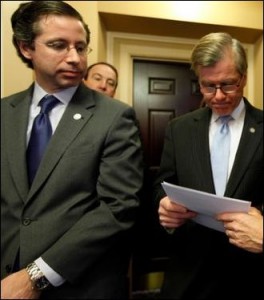by James A. Bacon
In New Jersey’s Bridge-gate scandal, Governor Chris Christie was cursed (if you believe his story) by underlings who made bad decisions that landed him in political hot water. In Virginia’s Gift-gate scandal, former Governor Bob McDonnell was blessed by underlings whose advice and actions kept him out of trouble — at least in those matters in which they were consulted.
But Jasen Eige, Phil Cox and Molly Huffstetler — all three of whom testified at the McDonnell trial yesterday — were powerless to protect the governor and his wife Maureen from bad judgment in matters they kept entirely to themselves.
As Jim Noland and Frank Green sum up the day’s testimony for the Times-Dispatch, “It is clear that a number of the governor’s aides and political advisers either were wary of [Star Scientific CEO and favor-seeker Jonnie] Williams, did not take him seriously or warned the first couple about the appearance caused his by his ostentatious gifts.” But they were unaware of the extent to which Williams was bankrolling the family because the McDonnells never told them.
McDonnell’s aides frequently engaged in damage control.
- The dress. When Williams offered to buy Maureen McDonnell an Oscar de la Renta dress for the inaugural ball, Jason Eige, senior policy adviser to McDonnell, nixed the offer. With the company coming out of a recession, it would not look good for her to wear such expensive apparel. Phil Cox, the governor’s former campaign manager, also acted to dissuade the First Family from accepting the gift.
- The clinical trials. When the governor e-mailed him about meeting to discuss Virginia Commonwealth University and University of Virginia research support for Williams’ Anatabloc dietary supplement, Eige warned, “We need to be careful with this issue.” It is not clear from newspaper accounts whether that meeting ever transpired, but it appears that the governor did not pursue the matter.
- The clinical trials (redux). Huffstetler, a top aide to Health and Human Resources Secretary Bill Hazel, met at the governor’s request with Williams and the First Lady in her office for an hour. She listened to Williams’ pitch for state support then responded with “a blowoff email.” In private, she referred to Williams as “the Tic Tac man.” The governor did not pursue the matter.
- The board appointment. When Maureen inquired about an appointment to the Star Scientific board, Eige expressed his concern that such an appointment would have “bad public optics.” That ended that.
- Tobacco money. When Maureen complained that VCU and UVa were not applying for grant money from the Tobacco Indemnification and Community Revitalization Commission to research Anatabloc, and asked to set up a meeting, Eige stalled. Even though the first lady had stated the governor shared her concern, Eige never heard from him. The stall worked and the meeting was never scheduled.
- The launch luncheon. Maureen arranged the use of the governor’s mansion to host the product launch of Anatabloc. Eige and other top aides warned that was not an appropriate use of state property. Eige managed to downgrade the event from a product launch to a luncheon in which Williams would distribute research grants to medical school researchers. He and Communications Director Tucker Martin also edited a Star Scientific press release to remove mention of the Governor and First Lady to avoid the appearance that they were endorsing a particular product.
- Pitching Ann Romney. On a campaign bus with Republican candidate Mitt Romney and his wife, Maureen pitched Ann Romney on the benefits of Anatabloc. “I was horrified,” testified Cox. “I thought it was a train wreck. I thought it was improper that Maureen would try to push this product on Ann Romney.” He interrupted the sales pitch at a break in the conversation and helped change the subject.
Here’s my hypothesis of what was going on. Bob McDonnell didn’t like saying, “No,” to his wife. (Perhaps we’ll get testimony of what domestic life was like in the governor’s mansion but testimony so far suggests that she had a very bad temper.) He knew that some of the things she wanted to do were either potentially illegal or had “bad optics” but didn’t have the emotional stamina to stand up to her nagging and harangues. It was easier to kick things over to staff and let them take the heat.
And take the heat they did. As Eige testified in connection to block the purchase of the Oscar de la Renta dress, the first lady “wasn’t happy with us [regarding] the dress situation.” Likewise, Cox described her response as “an insane rant of an e-mail.” In a different incident, according to Willliams, Maureen’s chief of staff Mary-Shea Sutherland asked him for a job, confiding that “she was tired of the way she was treated.”
It is notable that McDonnell never applied pressure on his staff to do anything other than meet with Williams. He could plausibly say to Maureen and Williams (my quotes) that he “did something” by setting up a meeting, which was a routine gubernatorial practice, but “there was only so much he could do.” As a former Attorney General, McDonnell assuredly knew where the line of legality was, and he knew not to cross it…. in most instances.
As some have observed, it is “ungallant” to heap the blame on Maureen. But it’s hard to avoid doing so. Every scintilla of evidence presented so far suggests that the first lady was out of control. When frustrated, she flew into fits of anger. Her husband couldn’t handle her. His aides were continually running damage control.
As far as McDonnell himself, the most troubling evidence to surface to date is that which suggests he conspired with Williams to take two real estate loans totaling $70,000 to bail out his bad real estate investments and discuss how to cover up the transaction. I withhold judgment until McDonnell gives his side of the story. But he’s got some serious explaining to do.



